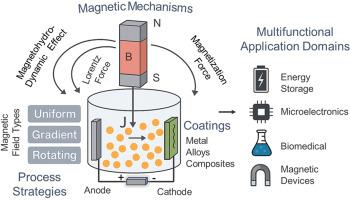磁场辅助电沉积:机制、材料和多功能应用
IF 6.8
3区 材料科学
Q1 MATERIALS SCIENCE, MULTIDISCIPLINARY
Journal of Science: Advanced Materials and Devices
Pub Date : 2025-08-06
DOI:10.1016/j.jsamd.2025.100967
引用次数: 0
摘要
磁场辅助电沉积(MFAED)是一种新兴的电化学策略,用于定制具有可控形貌,晶体取向和界面性能的功能涂层。通过引入外部磁场,MFAED通过洛伦兹力、磁场梯度和磁流体动力学(MHD)对流动态调节离子传输、成核动力学和晶粒生长。这些场致现象增强了质量输运,促进了各向异性晶体的演化,有效地解决了传统电沉积的局限性。本文综述了MFAED的基本原理,包括磁场结构、沉积机制以及磁场强度和方向对结构-性能关系的影响。多物理场建模的最新进展也被用来阐明耦合的电化学-流体动力学相互作用,并为过程优化策略提供信息。讨论了MFAED在储能、微电子和生物医学涂层中的代表性应用,重点讨论了其在催化活性、导电性、耐腐蚀性和生物相容性方面的改进。持续存在的挑战,如有限的可扩展性、不一致的涂层均匀性和对耦合场现象的不完全理解,都被严格评估。强调了未来的研究方向,包括可编程现场控制的集成,与混合刺激(如超声波,脉冲电流)的耦合,以及在柔性或地形复杂基底上的应用。总的来说,这些见解为MFAED作为下一代表面和界面工程的通用平台的发展奠定了基础。本文章由计算机程序翻译,如有差异,请以英文原文为准。

Magnetic field-assisted electrodeposition: Mechanisms, materials, and multifunctional applications
Magnetic field-assisted electrodeposition (MFAED) is an emerging electrochemical strategy for tailoring functional coatings with controllable morphology, crystallographic orientation, and interfacial properties. By introducing external magnetic fields, MFAED dynamically regulates ion transport, nucleation kinetics, and grain growth through Lorentz forces, magnetic field gradients, and magnetohydrodynamic (MHD) convection. These field-induced phenomena enhance mass transport and promote anisotropic crystal evolution, effectively addressing limitations associated with conventional electrodeposition. This review provides a comprehensive overview of MFAED fundamentals, including magnetic field configurations, deposition mechanisms, and the influence of field strength and orientation on structure–property relationships. Recent progress in multiphysics modeling is also examined to elucidate coupled electrochemical–hydrodynamic interactions and inform process optimization strategies. Representative applications of MFAED in energy storage, microelectronics, and biomedical coatings are discussed, with emphasis on improvements in catalytic activity, electrical conductivity, corrosion resistance, and biocompatibility. Persistent challenges—such as limited scalability, inconsistent coating uniformity, and incomplete understanding of coupled-field phenomena—are critically assessed. Future research directions are highlighted, including the integration of programmable field control, coupling with hybrid stimuli (e.g., ultrasound, pulsed currents), and application to flexible or topographically complex substrates. Collectively, these insights establish a foundation for advancing MFAED as a versatile platform for next-generation surface and interface engineering.
求助全文
通过发布文献求助,成功后即可免费获取论文全文。
去求助
来源期刊

Journal of Science: Advanced Materials and Devices
Materials Science-Electronic, Optical and Magnetic Materials
CiteScore
11.90
自引率
2.50%
发文量
88
审稿时长
47 days
期刊介绍:
In 1985, the Journal of Science was founded as a platform for publishing national and international research papers across various disciplines, including natural sciences, technology, social sciences, and humanities. Over the years, the journal has experienced remarkable growth in terms of quality, size, and scope. Today, it encompasses a diverse range of publications dedicated to academic research.
Considering the rapid expansion of materials science, we are pleased to introduce the Journal of Science: Advanced Materials and Devices. This new addition to our journal series offers researchers an exciting opportunity to publish their work on all aspects of materials science and technology within the esteemed Journal of Science.
With this development, we aim to revolutionize the way research in materials science is expressed and organized, further strengthening our commitment to promoting outstanding research across various scientific and technological fields.
 求助内容:
求助内容: 应助结果提醒方式:
应助结果提醒方式:


